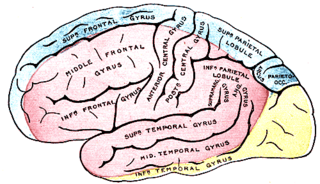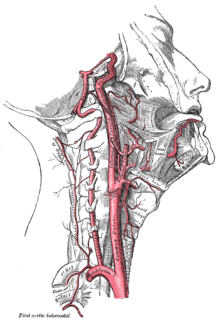This page is based on this
Wikipedia article Text is available under the
CC BY-SA 4.0 license; additional terms may apply.
Images, videos and audio are available under their respective licenses.

The external carotid artery is a major artery of the head and neck. It arises from the common carotid artery when it splits into the external and internal carotid artery. It supplies blood to the face and neck.

The internal capsule is a white matter structure situated in the inferomedial part of each cerebral hemisphere of the brain. It carries information past the basal ganglia, separating the caudate nucleus and the thalamus from the putamen and the globus pallidus. The internal capsule contains both ascending and descending axons, going to and coming from the cerebral cortex. It also separates the caudate nucleus and the putamen in the dorsal striatum, a brain region involved in motor and reward pathways.

The scalp is the anatomical area bordered by the human face at the front, and by the neck at the sides and back.

The posterior cerebral artery (PCA) is one of a pair of arteries that supply oxygenated blood to the occipital lobe, part of the back of the human brain. It begins near where the posterior communicating artery and the basilar artery join, and connects with the middle cerebral artery of the same side and internal carotid artery via the posterior communicating artery.

In human anatomy, the superficial temporal artery is a major artery of the head. It arises from the external carotid artery when it splits into the superficial temporal artery and maxillary artery.

The ascending pharyngeal artery is an artery in the neck that supplies the pharynx, developing from the proximal part of the embryonic second aortic arch.

The posterior meningeal artery is the largest vessel supplying the dura region of the posterior fossa. It typically arises from the ascending pharyngeal artery although other origins have been seen, such as the occipital artery. The artery or its branches enter the cranium through jugular foramen, foramen magnum or hypoglossal canal.

The mastoid foramen is a hole in the posterior border of the temporal bone. It transmits a Mastoid emissary vein to the sigmoid sinus and a small branch of the occipital artery, the posterior meningeal artery to the dura mater.

The posterior auricular nerve arises from the facial nerve close to the stylomastoid foramen and runs upward in front of the mastoid process; here it is joined by a filament from the auricular branch of the vagus and communicates with the posterior branch of the great auricular as well as with the lesser occipital.

The deep cervical artery is an artery of the neck.

The carotid triangle is a portion of the anterior triangle of the neck.
In anatomy, temporal branches can refer to any one of several different structures near the temple or temporal bone:

Posterior cerebral artery syndrome is a condition whereby the blood supply from the posterior cerebral artery (PCA) is restricted, leading to a reduction of the function of the portions of the brain supplied by that vessel: the occipital lobe, the inferomedial temporal lobe, a large portion of the thalamus, and the upper brainstem and midbrain.

The posterior branches of cervical nerves branch from the dorsal rami of the cervical nerves.

The two sternocleidomastoid branches of the occipital artery arise directly from the occipital artery and are the initial two branches of this artery. Uncommonly, the lower sternocleidomastoid branch can branch directly from the external carotid.

The occipital branch of posterior auricular artery passes backward, over the Sternocleidomastoideus, to the scalp above and behind the ear. It supplies the Occipitalis and the scalp in this situation and anastomoses with the occipital artery.
Occipital branch may refer to

The descending branch of occipital artery, the largest branch of the occipital, descends on the back of the neck, and divides into a superficial and deep portion.

The auricular branch of occipital artery supplies the back of the concha and frequently gives off a branch, which enters the skull through the mastoid foramen and supplies the dura mater, the diploë, and the mastoid cells; this latter branch sometimes arises from the occipital artery, and is then known as the mastoid branch.












